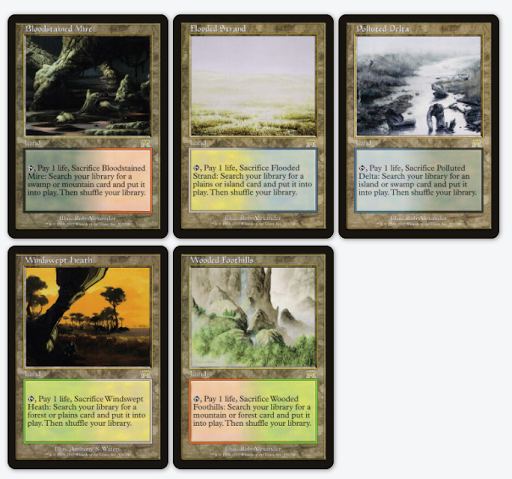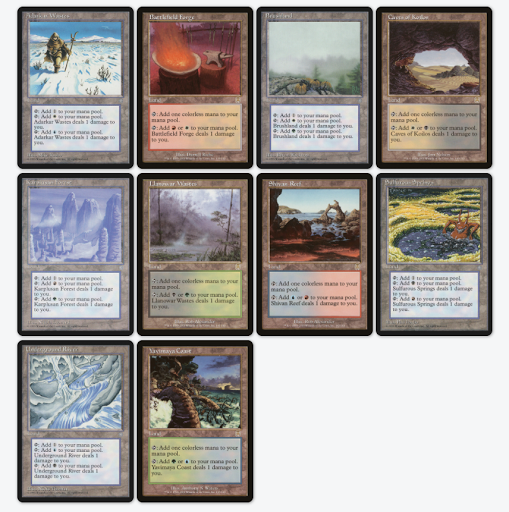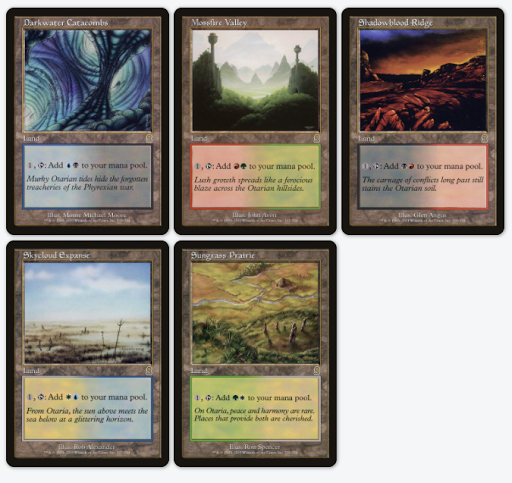Over the past month, I've been playing in a Middle School league put on by my friends at Romancing the Stones. I had played some Premodern over the past year and I've really enjoyed the deck building space in both formats. One thing that is clear about both formats: the mana is awful. I've played two instances of Constructed Set Roulette and observed a few others. Every time, the six random sets provide better options for mana bases than Premodern or Middle School. I want to spend this post looking at what causes the mana to be so bad, what that means for deck construction, and some overlooked synergies.
Premodern vs. Middle School
The format rules for Premodern and Middle School are very similar. They both focus on the time period of Magic sets between traditional 93/94 Old School and the official Modern format. Both include an extensive banned list that allows for some classic Standard decks from this era, and some of the weaker Extended decks. There are three major differences between the two formats:
1. Premodern uses current 2020 Magic the Gathering rules. Middle School uses some rules from 1995-2003, specifically mana burn, damage on the stack, and pre-exile zone Wish functionality.
2. Premodern uses sets that were Standard legal from 4th edition through Scourge. Middle School allows Portal sets, as well as reprint sets printed in this time period like Chronicles / Renaissance and Anthologies. Anthologies allows for some strange cards to show up that you might not expect, like Pendelhaven and Hymn to Tourach.
3. The major differences in the banned cards: Premodern bans both Necropotence and Force of Will, while Middle School allows these. There are other differences that somewhat relate (Dark Ritual is banned in MS), but these are the two major ones in my opinion. Relevant to my post today, both ban Brainstorm.
I think overall I prefer the Premodern rules and cards. I much prefer using current rules without mana burn etc. I also support Force of Will being banned, if only to give the format a different feel from Legacy. I think I prefer Portal sets allowed, but I don't like the confusion of the reprint sets (Anthology specifically). However, I'm not in charge of the events, so I play what they tell me is allowed.
Historical Mana Base Context
The majority of decks that are played in these formats are decks that were played in the old Extended format. When examining the mana of these old decks however, there are some issues.
Extended was created in 1997 and allowed cards from The Dark and Revised. Importantly, this meant original ABU dual lands were legal. These are the gold standard for dual lands (see my rankings of best dual land cycles at the end of this old post) and cover all 10 color pairs. When Extended rotated in 1999 to remove Revised and 4th edition, these dual lands were excepted and allowed to be played despite not being in one of the included sets. These remained legal until the printing of Onslaught and the rotation before PT Houston in 2002.
If you look at those dates and compare to the dates of sets covered by Premodern/MS, you see that for all but the final year of the 1995-2003 window the original dual lands were played in Extended. For those playing Premodern/MS for a nostalgic experience, it can be quite a shock that some of your favorite decks just don't function because the mana is so awful.
One reason for not allowing dual lands in Premodern/MS is to keep the price of entry down. Many of the staples of Premodern decks are quite affordable (though the reserved list exceptions are very very expensive as seen by recent Mox Diamond and Gaea's Cradle spikes). Additionally, fetch lands from Onslaught are a major part of the format and fetch-dual mana bases are too good.
My Suggestions
I have yet to prove my case that mana in Premodern/MS is awful, but here are some alternatives I would like to suggest.
1. Allow original dual lands in the format, but ban fetch lands. This is a big hit to the affordability of the format, but restores some formerly exciting cards to their old power levels (Land Grant, Tithe, Eternal Dragon, Mirage slow fetches). Additionally, banning fetch lands is not without precedent (see Pioneer) and allows Brainstorm to be unbanned. Having to go out of your way to play cards that shuffle is a large enough cost to playability I would not expect it to be ubiquitous like in Legacy.
2. Allow the five enemy-colored fetch lands to be legal. Enemy color mana bases are significantly weaker than allied colored mana bases. This would allow them to be mostly on the same level, with the limitations being less frequently played cards like Skycloud Expanse etc.
3. Extended the format to include Ravnica block shock lands and ban the Onslaught fetch lands. I think shock land / pain land formats are the best for mana bases, balancing between aggressive, controlling, and midrange strategies. Additionally, I think a lot of the classic Extended decks I remember include cards from some of these sets. Including Time Spiral and Timeshifted cards lets you add even older cards in a roundabout way. The real shift in design wasn't with card frame change and either came in Lorwyn block with Planeswalkers (these 5 are mostly harmless), or Alara block with Mythic Rares. You lose the appeal of only old card-frame, but the formats already allow new-framed printings. I personally would select a set through Eventide and call it Pre-Mythic.
There are many ways to mix and match some of these ideas, and I want to encourage those running events to think outside the box and not just do something that someone else prescribes without agreeing 100%.
The Mana
After 1000 words, we finally get to the good stuff. I will look at the tools available in Premodern/MS and discuss the implications of them with regards to deck building.
Fetch Lands
 |
| Fetch lands from Onslaught |
Fetch lands without dual lands to fetch are not very good. I ranked them 9th when I ranked dual land cycles six years ago. I still think that ranking is accurate. Fetch lands fail to support decks with CC cards in more than one color. It is greedy to expect to be able to play both White Knight and Counterspell on turn two with a given mana base, but it is not unreasonable to expect Counterspell and Wrath of God. A turn one fetch land can only help cast one of those cards, and the decision sometimes must be made before you know which other lands you draw. Fetch lands require a lot of shuffling as many others have noted, but that isn't a big issue in a format that isn't played under the tightest rules enforcement levels. B
The format with fetch lands as the primary dual lands leads to some interesting ramifications.
1. Decks almost always have a primary color and a secondary color supported by the fetch land. This secondary color can't have too many cards with CC in the cost. This limits which cards are playable in the format.
2. All the fetch land decks play lots of basic lands. I've seen lists with up to 16 basics. This means the card Wasteland is surprisingly ineffective. Other cards like Blood Moon, Back to Basics, and Price of Progress see almost no play. While this might be seen as a good thing, I think it stifles creativity and risk taking. I like when the format lets you take risks on playing a third or fourth color but you can get punished. I also like when you can mitigate the risks by choosing to play a one or two color deck. This format makes those choices for you.
 |
| Wasteland isn't very good in this format |
3. Enemy colors don't have these. Allied colors are preferred.
4. Brainstorm must be banned if these are legal.
Pain Lands
 |
| Pain lands from Ice Age and Apocalypse |
From the first printing in Ice Age until the printing of shocklands in Ravnica, these were the essential dual lands for Standard. I ranked them 3rd when I ranked cycles, which may have been too high, but they are effective. I wish these would see more Standard play in current formats.
These are the default lands you will see in just about every two-color deck. They skew aggressive, but control decks likely won't have more than four in the entire deck so the drawback is manageable. If you plan on playing a lot of Premodern/MS, you should pick up a set of 40 of these. They are also fairly affordable since they don't see play in many other formats.
Filter Lands
 |
| Filter Lands from Odyssey |
These aren't very good (I ranked them 10th in my post from six years ago). They do two interesting things I want to point out.
1. They turn colorless mana into colored mana. This is useful for things like Mishra's Factory and Skycloud Expanse in Landstill decks. Also makes the colorless option from pain lands better.
2. They only exist in allied colors, further skewing the metagame to only allied color decks.
Mirage Fetches and Invasion Duals
 |
| Fetch Lands from Mirage and ETB Tapped Lands from Invation |
I group these together because they have almost identical functionality in Premodern/MS. It's hard to believe, but the printing of Coastal Tower et al. was a pretty big deal in the day. The Invasion lands are almost always better than Mirage except against the non-basic hate cards. Both are weak enough you should never play them.
There are some other cycles of dual lands I won't go over in detail, but they are almost all strictly worse than the ones I've discussed above. These include Ice Age depletion lands, Homelands filter lands, Tempest ETB tapped pain lands and delay lands. Avoid at all costs.
Lairs
 |
| Lairs from Planeshift |
These are a personal favorite of mine in Premodern/MS. These may look awful at first glance (and in the realm of all of Magic, they are terrible indeed), but there are specific reasons why they are better than they look.
1. They are the second (or third) option for enemy colors. Don't look at them as three color lands, but as enemy dual lands with significant drawbacks. Crosis's Catacombs is Volcanic Island when you squint hard enough. As we've seen above, there is a dearth of options for enemy color decks.
2. The draw back is real, but manageable. Because of the card Counterspell, you notice the majority of spells in Premodern/MS fall in the one and two CMC range. These lands let you cast those two mana spells on turn two, and if your deck isn't trying to cast a four mana spell, the drawback won't be that painful.
3. There are some interesting ways to use these for real or psuedo-advantage. Using these with Mox Diamond can let you cast a variety of spells of different colors with CC requirements starting on turn two. (Turn one basic, turn two lair plus Mox you now have a very solid manabase.) They can also be used with Thawing Glaciers to fix mana further without being set back at all. (Turn one Glaciers, turn two Lair activate Glaciers with the trigger on the stack, then return the Glaciers with the Lair.)
Here are two decks that take advantage of lairs (or could take advantage):
 |
| RW Tax Rack by Nathan Golia |
 |
| Turboland by Ty Thomason |
The RW tax deck could use Lairs to fix the mana while still letting Land Tax trigger. Additionally, it wants to cast Devestating Dreams as well as some WW spells like Soltari Priest. Rith's Grove can help this deck a lot at casting spells while the drawback isn't as severe.
The UG Turboland deck uses the aforementioned Thawing Glaciers trick, as well as Explore plus Horn of Green to turn Treva's Ruins' drawback into a benefit.
5 Color Lands
 |
| The playable 5 color lands in Premodern / Middle School |
These are somewhat reasonable as second or third options in enemy color decks. They also enable some five color strategies. None are so good to be widely played, but they show up when you need them. Keep them in mind. Note that Gemstone Mine works well with Lairs
The Artifacts
 |
| Lotus Petal and Mox Diamond |
Mox Diamond has a lot of synergy with the land return cards from Masques block, mainly Daze and Gush. There isn't much incidental hate for it. Mana costs being low means drawing extra isn't that much worse than drawing extra lands. I'm going to be exploring some more in the Mox Diamond space in the future.
Fast Mana
 |
| These all tap for two mana! |
Like the five color lands, you will know when you want these. These are ways to get out of the one and two mana spell fest that is the rest of the format. Dark Ritual is also worth mentioning here, but it is banned in Middle School.
Thawing Glaciers
 |
| Thawing Glaciers, AKA Slowest Fetch |
This card is pretty good at getting your splash color in a two or three color deck. It also is very important in control mirrors where making land drops is vital. It can fuel Dust Bowl (if Dust Bowl was any good) or combo with Lairs. I think this card should see more play in general.
Other lands to remember
Creature lands like Mishra's Factory and Treetop Village are big parts of the format. Gaea's Cradle is very good, but Tolarian Academy is banned and Serra's Sanctum not that great. Rishadan Port and Dust Bowl might be better than Wasteland. There are still a lot of lands that might be okay if you give them a chance. I didn't think Lairs would be playable at all until I put them in my deck; now I'm looking for more ways to play them.
Some future programming notes
I've recently started school. This combined with working part time will probably take up more of my free time than before. I don't know how much Magic I'll actually be able to play, and even more skeptical about how much time I'll have to write. So this may be my last blog post for a while.
No comments:
Post a Comment